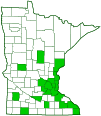blackberry lily
(Iris domestica)
Conservation • Wetland • Description • Habitat • Ecology • Use • Distribution • Taxonomy
Conservation Status |
|
|||||||
| IUCN Red List | not listed |
|||||||
| NatureServe | NNA - Not applicable |
|||||||
| Minnesota | not listed |
|||||||
Wetland Indicator Status |
||||||||
| Great Plains |
|
|||||||
| Midwest |
|
|||||||
| Northcentral & Northeast |
|
|||||||
Description |
||
Blackberry lily is an erect, 12″ to 40″ tall, perennial forb that rises on a cluster of basal leaves and a leafy stem from a thickened crown at the base of the plant, underground stems (rhizomes), and fibrous roots. The rhizomes are shallow, stout, orangish-yellow, and creeping. It sometimes forms dense colonies. Basal leaves are linear, green to grayish-green, 12″ to 24″ long, and ⅜″ to ¾″ wide. They are half as long to as long as the flowering stem. The basal third to half of the leaf is folded longitudinally, the remainder flat. The tip is sharply pointed. The leaf blade is parallel-veined and lacks a prominent midvein. The upper and lower surfaces are hairless and covered with a whitish, waxy bloom (glaucous). The margins are untoothed. Basal leaves are often spread out fan-like. Stem leaves are arranged alternately in two overlapping ranks. They are shorter, stalkless, and narrowly lance-shaped to linear, but otherwise similar to basal leaves. The stem is erect or ascending, pale green, hairless, glaucous, round in cross section, and 24″ to 40″ long. It usually has 3 to 5 branches but may be unbranched. The inflorescence is a flattened, branched cluster (cyme) of 3 to 6 large flowers at the end of each branch. A pair of modified leaves (bracts) subtend each node of the inflorescence. The flowers are 1¼″ to 2″ in diameter and have a ⅝″ to ¾″ long stalk. They are semi-erect or horizontal – they do not hang downward. There are 3 petals, 3 petal-like sepals (6 tepals), 3 stamens, and 1 style. The tepals are lance-shaped, ⅝″to 1⅜″ long, fused and ascending at the base, but separated and widely spreading for most of their length. They are orangish-red to orange with large, irregularly scattered, red to brownish-purple spots. A yellow version is available in cultivation. The sepals are slightly longer than the petals. The stamens have yellow to orange, ⅜″ to ½″ long filaments; and yellow, ¼″ to 5 ⁄16″ long anthers. The style is 3-angled near the base, thickened in the upper half, and split into 3 branches at the tip. The flowers bloom from dawn to dusk and last only a single day. Within each cluster only a single flower blooms at a time. At the end of the day they curl up on a tight spiral, appearing like what has been described as a wrung-out dishcloth. The flowers are not fragrant. The fruit is a green, egg-shaped, 1″ to 1 3 ⁄16″ long, ⅜″ to ¾″ in diameter capsule with 3 longitudinal lobes. When ripe it splits open along 3 fissures to reveal blackberry-like masses of round, shiny, black seeds. |
||
Height |
||
12″ to 40″ |
||
Flower Color |
||
Orange with red or purple spots |
||
Similar Species |
||
Michigan lily (Lilium michiganense) is much taller, 3′ to 6′ at maturity. The leaves are whorled except near the top, where they are single, in pairs, or in partial whorls. The flowers are much larger, 2½″ to 3″ wide, and hang downward. They are Turk’s-cap shaped, with tepals that bend backward to their base. Wood lily (Lilium philadelphicum var. andinum) upper stem leaves are whorled. |
||
Habitat |
||
Moist to dry. Hillsides, pastures, woodland openings, thickets, roadsides, old fields, old homesteads, disturbed areas. Full or partial sun. |
||
Ecology |
||
Flowering |
||
June to July |
||
Pests and Diseases |
||
|
||
Use |
||
|
||
Distribution |
||||
|
Sources |
|||
| 2/22/2023 | ||||
Nativity |
||||
Native to Asia. Introduced, cultivated, and escaped cultivation. Naturalized. |
||||
Occurrence |
||||
Uncommon |
||||
Taxonomy |
|||
| Kingdom | Plantae (Plants) | ||
| Division | Tracheophyta (Vascular Plants) | ||
| Subdivision | Spermatophytina (Seed Plants) | ||
| Class | Liliopsida (Monocots) | ||
Order |
Asparagales (Agaves, Orchids, Irises, and Allies) | ||
Family |
Iridaceae (irises and allies) | ||
| Subfamily | Iridoideae | ||
| Tribe | Irideae | ||
Genus |
Iris (irises) | ||
| Subgenus | Hermodactyloides | ||
Prior to 2005, the scientific name of blackberry lily was Belamcanda chinensis. It was the sole species in that genus. In that year, based on molecular DNA analysis, it was transferred to the genus Iris, and became Iris domestica. Some online sources, including USDA PLANTS, BONAP, EDDMapS, NatureServe, and FNA, and closer to home, Minnesota Biodiversity Atlas, retain the old name. |
|||
Synonyms |
|||
Belamcanda chinensis Gemmingia chinensis |
|||
Common Names |
|||
belamcanda blackberry lily leopard-lily |
|||
Glossary
Bract
Modified leaf at the base of a flower stalk, flower cluster, or inflorescence.
Cyme
A branched, flat-topped or convex flower cluster in which the terminal flower opens first and the outermost flowers open last.
Filament
On plants: The thread-like stalk of a stamen which supports the anther. On Lepidoptera: One of a pair of long, thin, fleshy extensions extending from the thorax, and sometimes also from the abdomen, of a caterpillar.
Glaucous
Pale green or bluish gray due to a whitish, powdery or waxy film, as on a plum or a grape.
Linear
Long, straight, and narrow, with more or less parallel sides, like a blade of grass.
Node
The small swelling of the stem from which one or more leaves, branches, or buds originate.
Rhizome
A horizontal, usually underground stem. It serves as a reproductive structure, producing roots below and shoots above at the nodes.
Sepal
An outer floral leaf, usually green but sometimes colored, at the base of a flower.
Tepal
Refers to both the petals and the sepals of a flower when they are similar in appearance and difficult to tell apart. Tepals are common in lilies and tulips.
Visitor Photos |
|||||
Share your photo of this plant. |
|||||
| This button not working for you? Simply email us at info@MinnesotaSeasons.com. Attach one or more photos and, if you like, a caption. |
|||||
Stuart |
|||||
Found on edge of new development in Stillwater, MN |
|||||
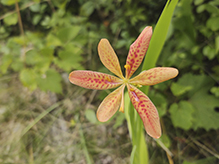 |
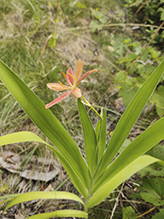 |
||||
Alora |
|||||
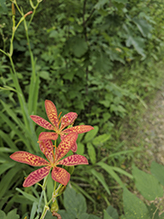 |
|||||
MinnesotaSeasons.com Photos |
|||||
Plant |
|||||
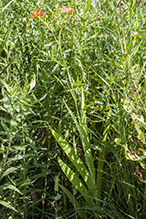 |
|||||
Inflorescence |
|||||
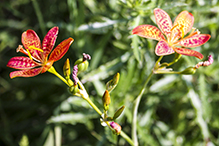 |
|||||
Flower |
|||||
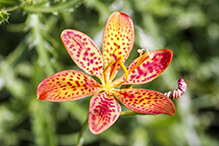 |
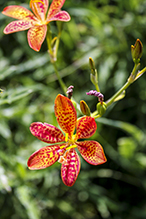 |
||||
Basal Leaves |
|||||
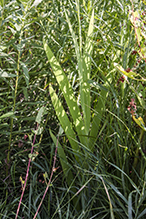 |
|||||

Slideshows |
||
| Plant portrait - Blackberry lily (Belamcanda chinensis) Identify that Plant |
||
About
Published on Sep 29, 2013 A detailed look at characteristics of Blackberry lily (Belamcanda chinensis). These images can help to accurately identify the plant during different seasons of the year. |
||
| 射干(Blackberry Lily ) Siokhui Fan |
||
About
Uploaded on Feb 11, 2012 射干 |
||
| Iris Doméstica fafapadula |
||
About
Uploaded on Mar 2, 2011 Minha flor preferida atualmente. |
||

Visitor Videos |
|||
Share your video of this plant. |
|||
| This button not working for you? Simply email us at info@MinnesotaSeasons.com. Attach a video, a YouTube link, or a cloud storage link. |
|||
Other Videos |
|||
| Blackberry Lily www.flowers.ms |
|||
About
Uploaded on Aug 15, 2011 Blackberry Lily |
|||
| Iris domestica Blackberry Lily dullard69 |
|||
About
Published on Aug 30, 2015 I call these orchid lilies myself because the flowers, at a glance look like "orchidish." They are also called Leopard Lilly. |
|||
| Iris domestica - Blackberry Lily ISU Horticulture Herbaceous Ornamentals |
|||
About
Published on Oct 29, 2013 Blackberry Lily |
|||
| FLOR-LEOPARDO + SEMENTES - Meu jardim ! veveblue |
|||
About
Published on Apr 11, 2013 Flor-leopardo ou lírio-leopardo. Belamcanda chinensis. Google translate: Flower Leopard or Leopard lily. Belamcanda chinensis. |
|||
| Leopard lily , Dieffenbachia, Ledebouria , Lilium catesbaei, , Lilium pardalinum, Iris domestica shyejyh |
|||
About
Published on Mar 1, 2015 |
|||


|
Created: Last Updated: © MinnesotaSeasons.com. All rights reserved. |
